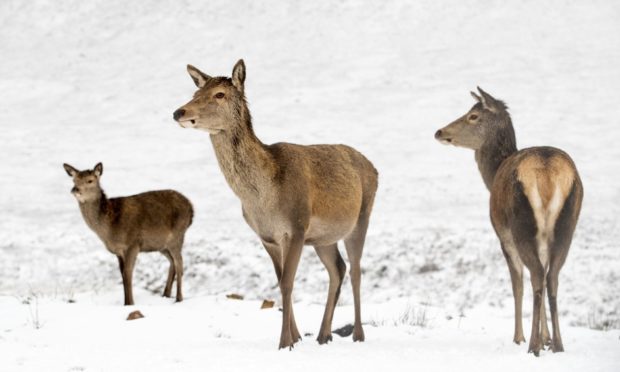A row has broken out between gamekeepers and a nature charity after a dog walker found the bloodied torsos of red deer lying in public view at a popular Highland beauty spot.
The woman, who doesn’t want to be named, was distressed at seeing the bodies of a hind and calf lying in “unnatural” positions in the Nevis Gorge area on land owned by the John Muir Trust (JMT).
She contacted the Scottish Gamekeepers Association (SGA), who have described her “disgust” at the discovery.
But the Trust, which has been locked in a battle against SGA for years over deer management, has since denied any involvement – and suggested the carcasses may have been arranged there “for a photo opportunity” by campaigners opposed to culling.
SGA chairman Alex Hogg said: “The lady didn’t want publicity but she was very upset and asked that we look into it because she loves seeing deer.
“She was basically disgusted.
“The area, around Steall Bothy, is well visited and what surprised her most was that this was the last thing she thought she would find in an area owned by a nature conservation charity.”
JMT has categorically denied leaving the carcasses close to the Glen Nevis footpath, and mooted the possibility that “hostile” individuals could be responsible.
JMT chief executive, David Balharry, said: “One of our contractors notified us on that, on the previous day, he had been surprised to see seven carcasses laid out near the public footpath.
“He and his colleagues had culled these deer several weeks earlier and left them higher on the hillside after removing as much as venison as possible.
“On discovering that the carcasses had been located to a more visible location, he proceeded to remove them from public sight.”
Mr Balharry said Glen Nevis culling takes place on challenging terrain, where it is impossible to get an all-terrain vehicle through the steep gorge and that carcasses were not always removed after deer were shot.
He added: “It is not possible to remove carcasses to the east, because of protected peatland. Nor are we prepared to use helicopters.
“That means our contractors remove venison from carcasses on the hillside and leave the remainder for raptors and other scavengers as a part of an arrangement we have with NatureScot.
“We believe this model of deer control will in the future allow greater community access to venison.”
Mr Balharry said the trust was curious as to why the carcasses had been dragged from the hillside and grouped closely together “for the purpose of photo opportunity”.
He said: “It is disappointing but not surprising that two weeks later, these images have found their way to the press.
“We are aware that there are some individuals and organisations who are hostile to the John Muir Trust because of the prominent roles we have played in supporting the reform of deer management practices in sporting estates.
“We note that this story has emerged just as the Scottish Government is about to announce its response to the report of the independent deer working group, which has proposed major changes to deer management in Scotland for the benefit of nature, local communities and climate.”
Bad blood goes back years between SGA and the trust.
In 2016, the SGA sought a parliamentary inquiry after 86 stags were left to rot on a Knoydart hillside, some with haunches and heads removed.
JMT said the deer were too difficult to extract at Li and Coire Dhorcail, claiming that 86 stags represented only just more than 1% of the 7,000-strong deer population on Knoydart.
In Assynt, local crofters and land managers have also clashed with the trust over 400 alleged missing deer after a JMT cull.
Bill Cowie of SGA deer group said: “Every few years these things seem to happen on John Muir Trust ground.
“On this occasion, there may have been some access problems extracting them from one side but it is known there is access out from the other.
“Do the public really want to see this when taking daily exercise? If not, they should write to their MSPs.”
Mr Balharry said the trust is concerned about the winter mortality of red deer as a direct result of ever-increasing numbers and the absence of sufficient food and shelter.
He said: “Humane culling of deer is required to protect animal welfare and reduce road collisions as deer desperately seek access to patches of grass at the roadside.
“Mortality rates from starvation and exposure are unacceptably high, especially in extreme winter conditions.
“The John Muir Trust and other responsible land managers work to improve the habitats that deer depend upon for food, and we maintain numbers by humane culling as an alternative to the extreme suffering of slow lingering death from starvation. We also act to protect woodland, restore peatland and other habitats, reduce carbon emissions and reverse biodiversity loss.
“As an organisation which has as its top priorities animal welfare, protection of habitats and carbon reduction, are satisfied that our contracted deer stalkers at Nevis are carrying out the necessary deer cull to the high standards that we demand.”
